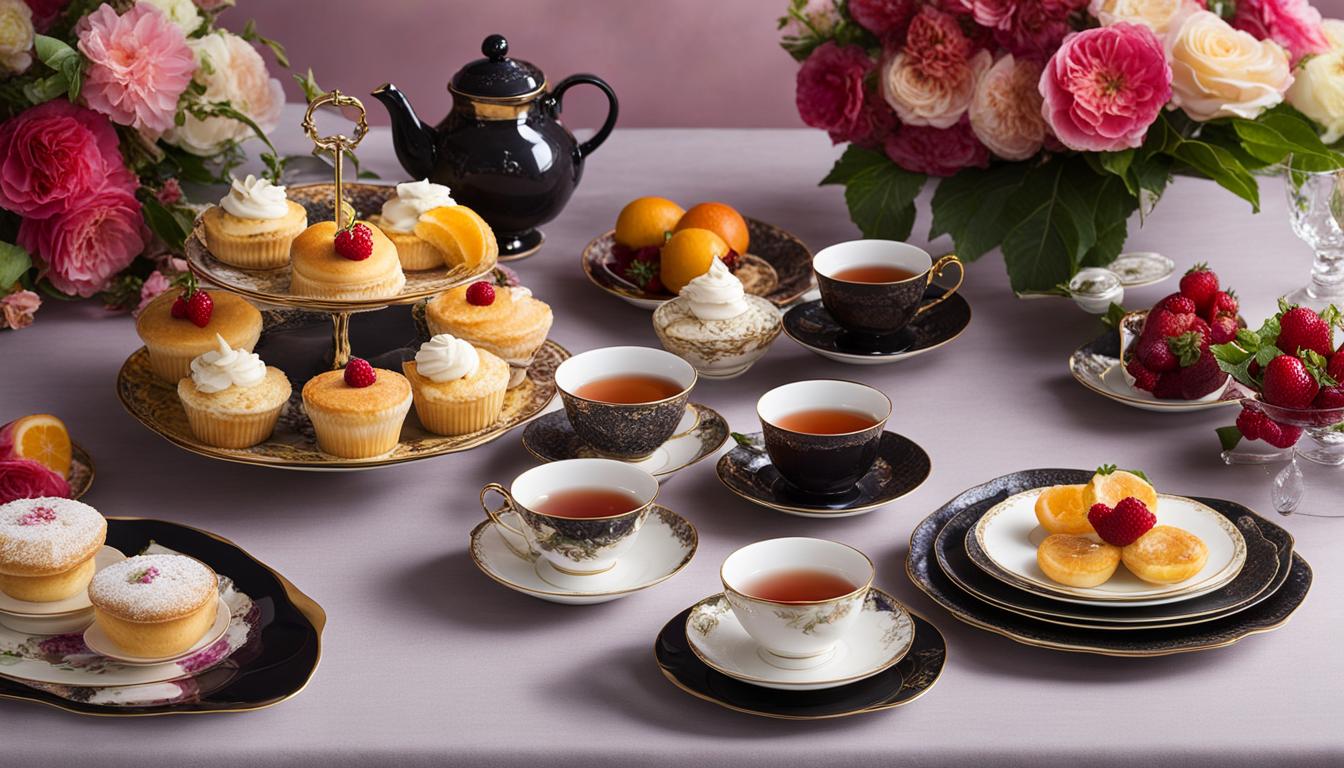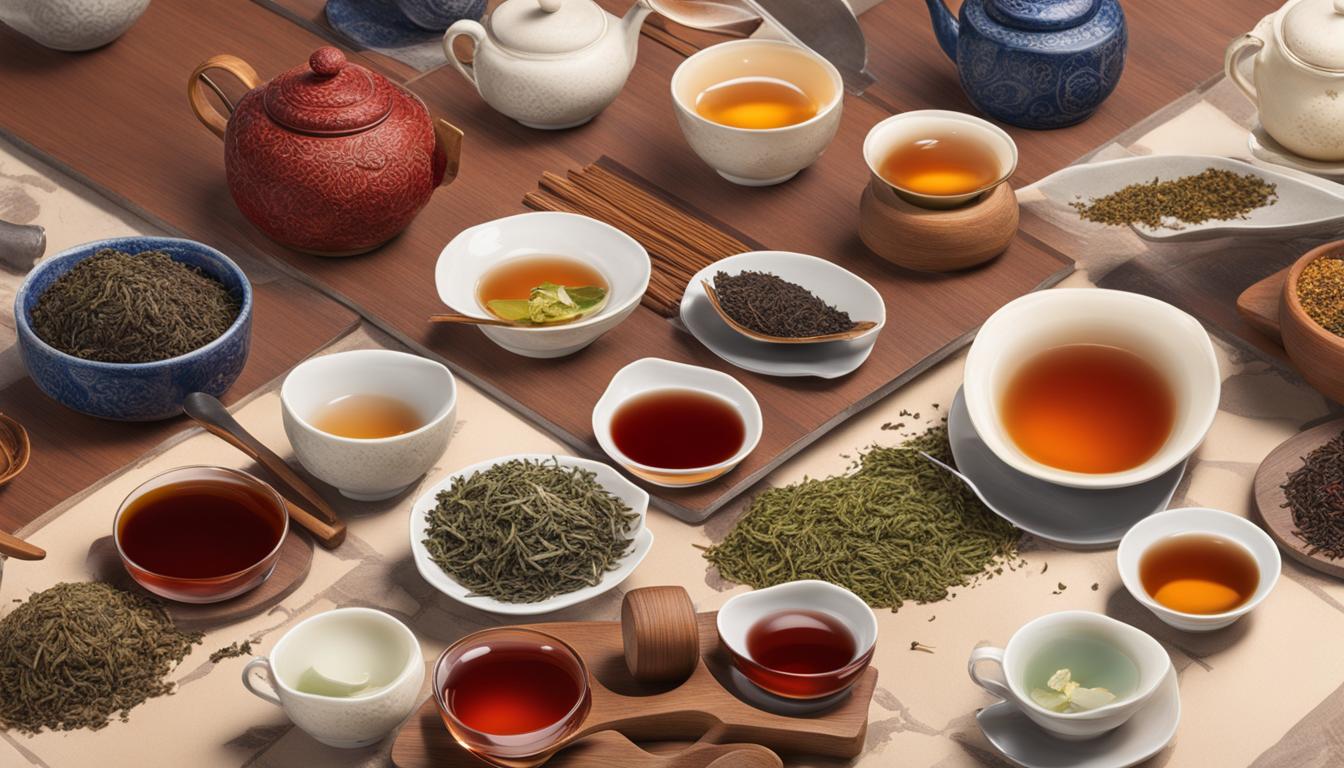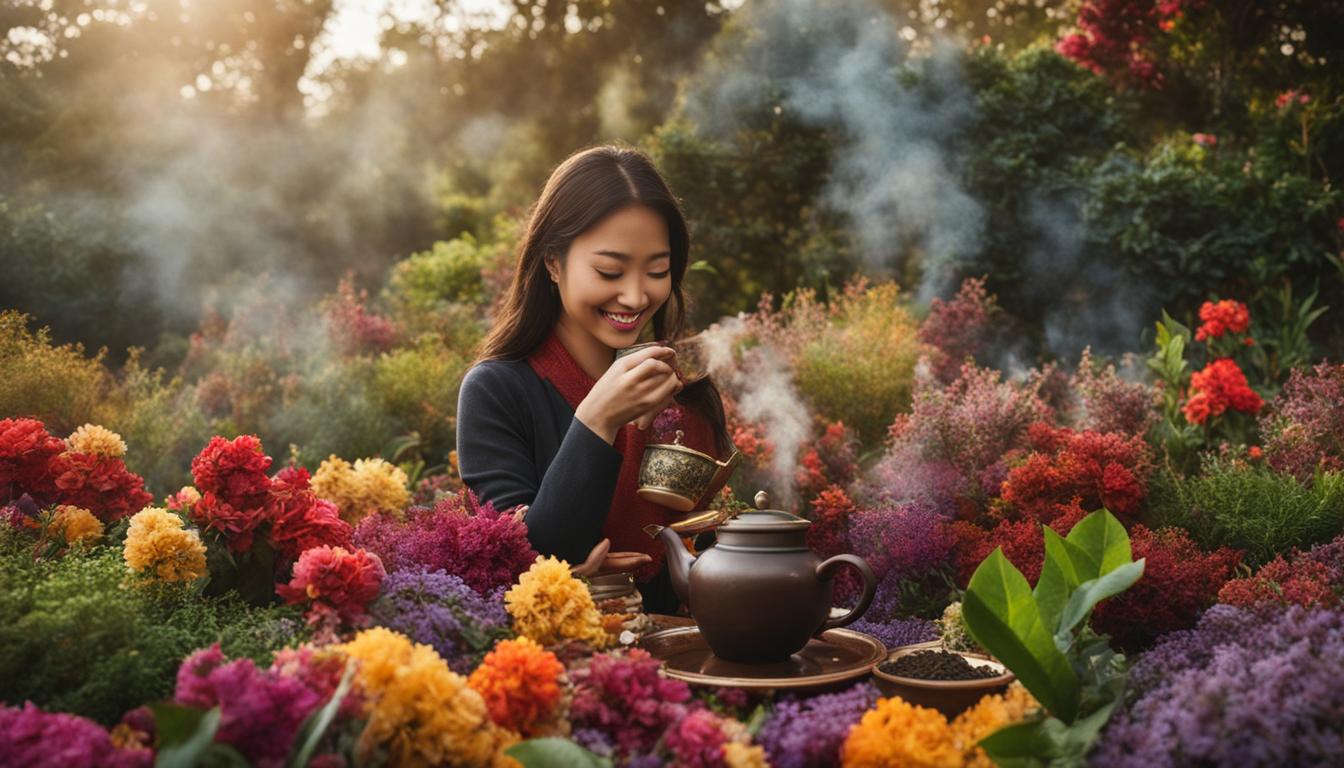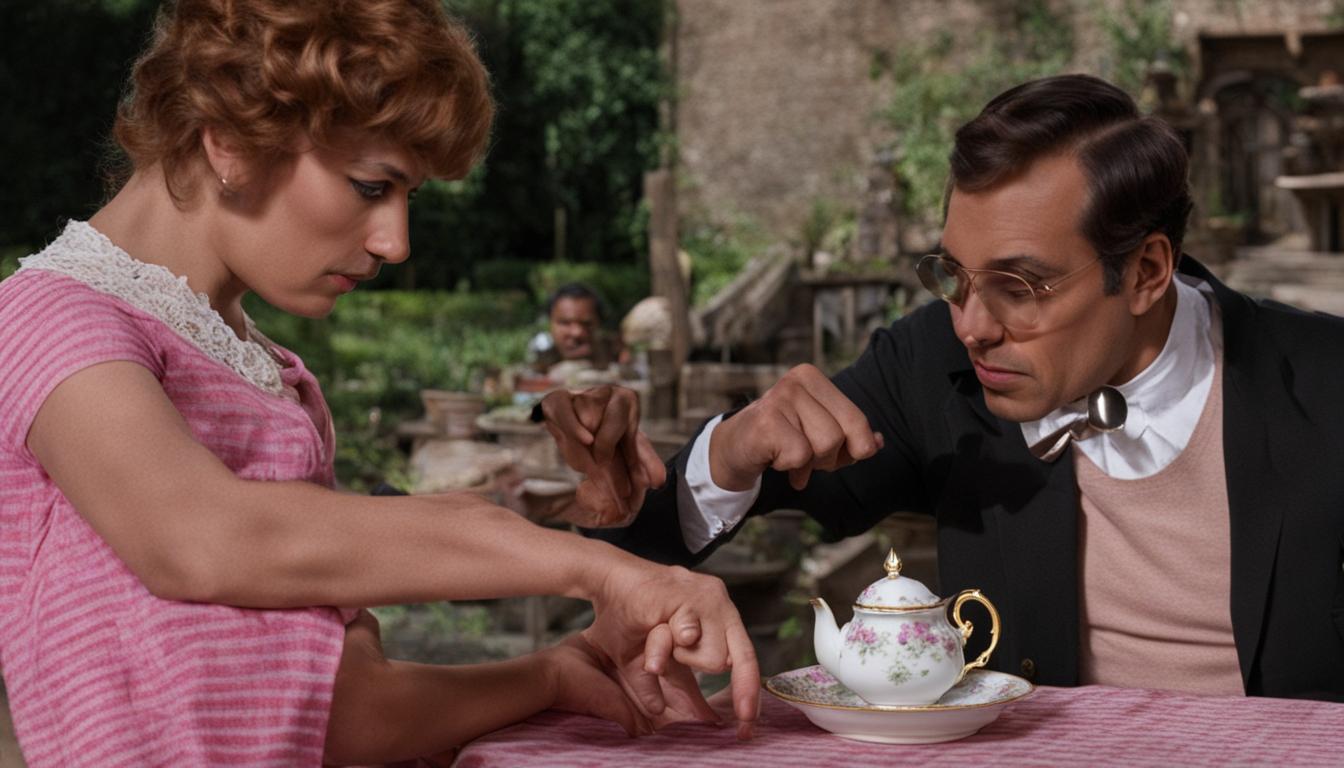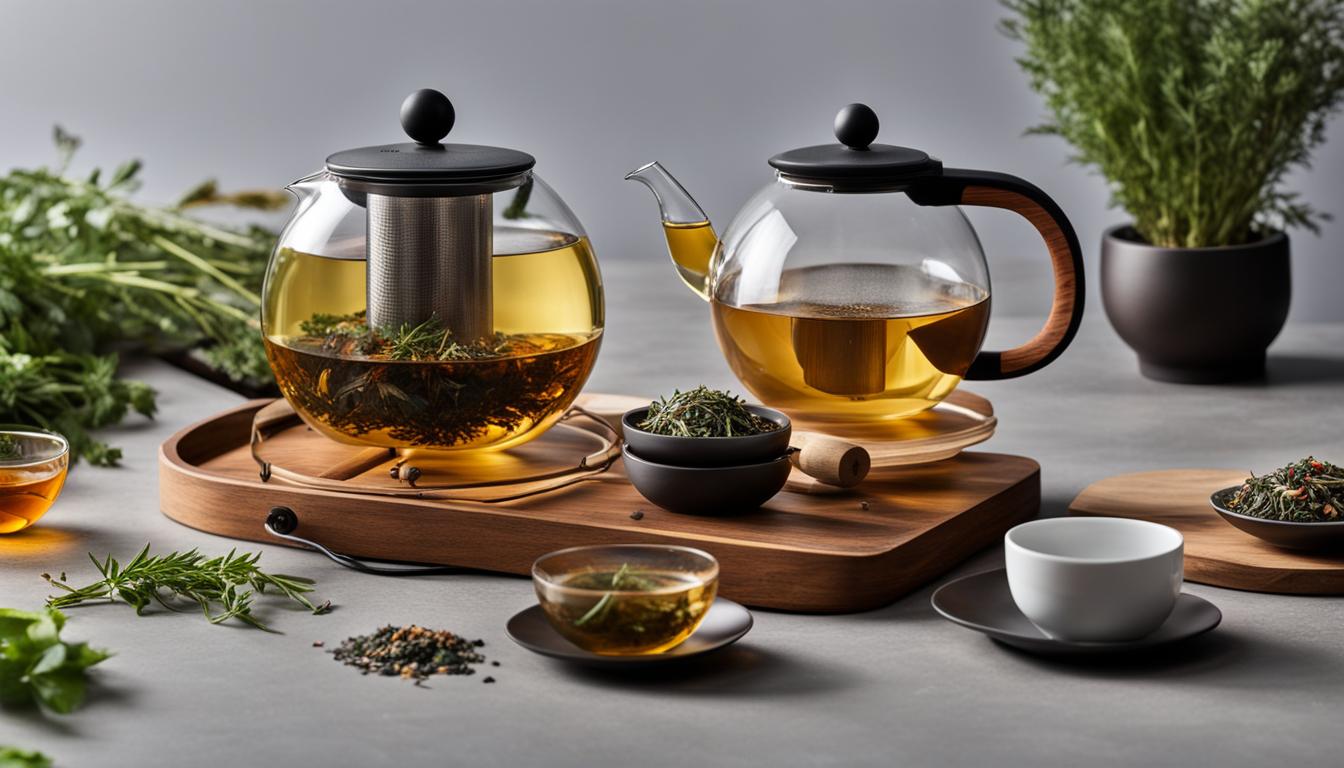Valentine’s Day is the perfect occasion to indulge in the luxurious combination of black tea and food. At we believe that tea pairing is an art that can elevate your dining experience to new heights. In this article, we will explore classic and innovative black tea pairings that will tantalize your taste buds and leave you craving for more.
Key Takeaways
- Black tea is a versatile beverage that can be paired with a wide range of foods.
- When it comes to barbecue, black tea can be the perfect accompaniment, enhancing the smoky flavors of grilled meats.
- For traditional roasts, black tea offers a rich and robust flavor profile that complements the hearty and savory dishes.
- Experiment with different black tea varieties and ingredients to discover your own unique flavor combinations.
- Whether you prefer classic pairings or want to explore innovative combinations, black tea is sure to enhance your dining experience.
Tea Pairings with White Tea
White teas offer a delicate flavor profile that pairs harmoniously with mild and subtle flavors. When considering tea pairings, Bai Mu Dan white tea is an excellent choice. Its gentle and floral notes complement a range of dishes, making it a versatile option. For a light and refreshing combination, pair Bai Mu Dan white tea with basmati rice. The floral undertones of the tea enhance the aromatic qualities of the rice, creating a delightful sensory experience.
In addition to rice, Bai Mu Dan white tea also pairs well with light fish dishes. The subtle flavors of the white tea do not overpower the delicate taste of the fish, allowing both elements to shine. Basic salads can also benefit from the addition of Bai Mu Dan white tea. The mild, slightly sweet characteristics of the tea complement the fresh and crisp flavors of the salad, adding a subtle layer of complexity.
Another white tea option for pairing is Dragonwell green tea. This tea variety exhibits a unique chestnut-like flavor with a hint of vegetal notes. Its distinct taste makes it a perfect companion for seafood or fish dishes. The natural sweetness of the Dragonwell green tea enhances the flavors of the seafood, creating a harmonious balance of tastes. Additionally, the slight vegetative undertones of the tea provide a refreshing contrast to the richness of the fish.

Table: Tea Pairings with White Tea
| White Tea | Food Pairings |
|---|---|
| Bai Mu Dan | Basmati rice, light fish, basic salads |
| Dragonwell | Seafood or fish dishes |
Tea Pairings with Green Tea
Green tea, with its subtle and vegetative flavor, offers a perfect canvas for pairing with mild or subtly-flavored foods. The delicate nature of green tea allows it to complement and enhance the flavors of various dishes. Let’s explore two popular green teas and their recommended food pairings:
Dragonwell Green Tea
Dragonwell, also known as Longjing, is a well-known green tea from China. Its smooth, nutty, and slightly sweet flavor profile makes it a versatile choice for pairing with a variety of dishes. Here are some suggested pairings:
- Seafood or fish: Dragonwell’s delicate flavor complements the freshness of seafood and fish dishes.
- Salads: Its subtle notes harmonize well with light and refreshing salads.
- Chicken: Dragonwell’s nutty undertones provide a delightful contrast to the savory flavors of chicken.
Sencha Green Tea
Sencha, a popular green tea from Japan, is known for its vibrant, grassy aroma and refreshing taste. Its lively character pairs exceptionally well with certain dishes. Consider these pairings when enjoying Sencha:
- Arugula and lightly steamed vegetables: Sencha’s bright and grassy notes bring out the freshness of arugula and lightly cooked vegetables.
When it comes to tea pairings, green tea offers a wide range of options. Whether you’re enjoying the nutty flavors of Dragonwell or the vibrant essence of Sencha, these teas can elevate your dining experience with their delicate and refreshing qualities.
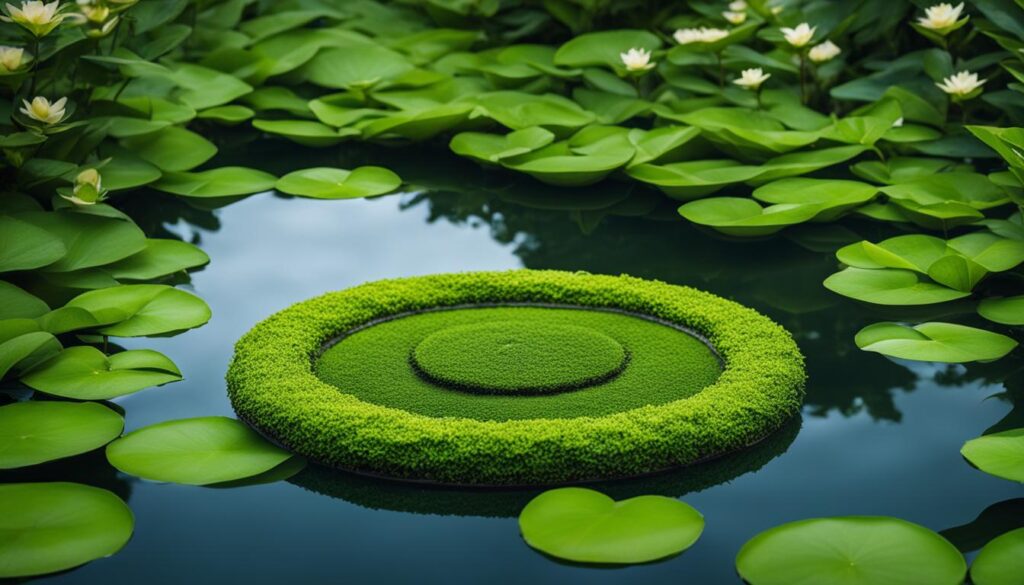
Table: Tea Pairings with Green Tea
| Green Tea | Food Pairings |
|---|---|
| Dragonwell |
|
| Sencha |
|
Tea Pairings with Oolong Tea
Oolong teas offer a unique and complex flavor profile, making them versatile for pairing with a variety of foods. There are two main categories of oolong tea: greener oolongs and darker oolongs. Each category has distinct characteristics that complement different dishes.
Greener Oolongs
Greener oolongs, also known as jade oolongs, have a lighter oxidation level, resulting in a fresh and floral flavor. These teas pair well with delicate flavors and seafood dishes. For a delightful pairing, try serving greener oolong tea with scallops or lobster. The tea’s subtle sweetness and floral notes will enhance the natural flavors of the seafood.
Darker Oolongs
Darker oolongs have a higher oxidation level, resulting in a richer and more robust flavor. These teas are ideal for pairing with heartier dishes and grilled meats. The boldness of the tea can stand up to the strong flavors of duck or grilled meats, creating a harmonious balance of taste.
To summarize, oolong teas offer a wide range of pairing possibilities. Greener oolongs are perfect for seafood dishes, while darker oolongs complement more robust and savory flavors. Experiment with different oolong teas and food combinations to discover your own unique and delightful pairing experiences.
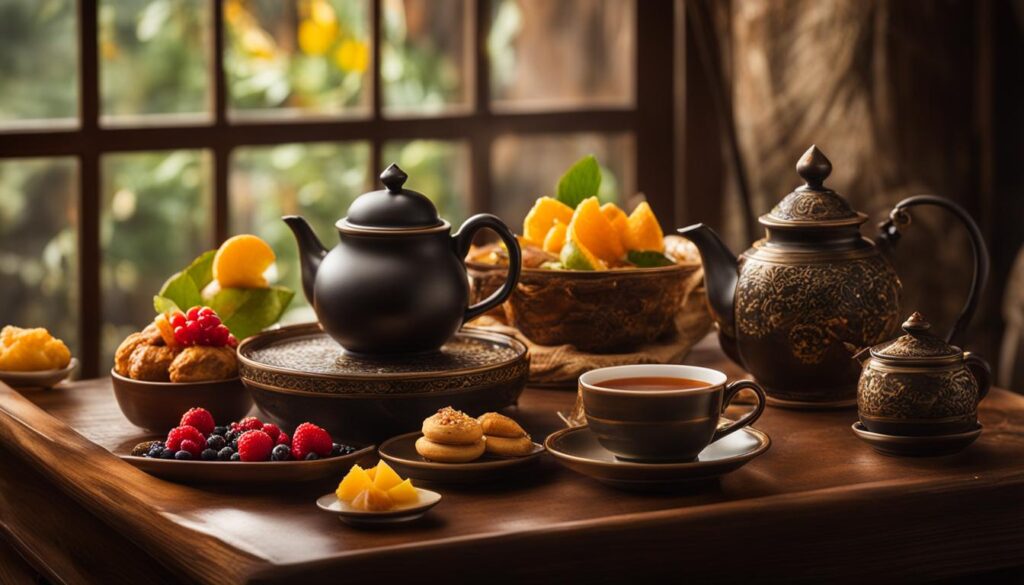
| Oolong Tea Type | Food Pairings |
|---|---|
| Greener Oolongs | Scallops, Lobster, Sweet Rich Foods |
| Darker Oolongs | Duck, Grilled Meats |
Tea Pairings with Black Tea
When it comes to tea pairings, black tea offers a robust flavor profile that can complement a wide variety of dishes. From savory to sweet, the versatility of black tea makes it a perfect choice for pairing with full-flavored foods. Here are some recommended black tea pairings to elevate your dining experience:
1. Darjeeling Black Tea
Darjeeling black tea, also known as the “champagne of teas,” is renowned for its floral notes and muscatel flavor. It pairs exceptionally well with egg dishes, such as quiches or omelettes, thanks to its delicate yet complex taste. For dessert, try pairing Darjeeling black tea with creamy desserts like custard or lemon tarts to create a harmonious balance between the tea’s light astringency and the sweetness of the desserts.
2. Keemun Black Tea
Keemun black tea hails from China and is well-known for its smoky aroma and deep, rich flavor. This tea pairs beautifully with a range of dishes, including meats, fish, Chinese cuisine, and spicy dishes. The robustness of Keemun black tea can stand up to bold flavors, making it a fantastic choice for hearty meals.
3. Assam Black Tea
Assam black tea originates from India and is known for its full-bodied and malty flavor. It pairs wonderfully with hearty foods and breakfast dishes. Enhance your morning meal by enjoying a cup of Assam black tea alongside a plate of scrambled eggs, bacon, or sausage. For dessert enthusiasts, Assam black tea pairs excellently with chocolate-based desserts, such as chocolate cake or brownies, creating a delightful balance between the bold tea flavor and the richness of chocolate.
| Black Tea | Food Pairings |
|---|---|
| Darjeeling | Egg dishes, creamy desserts |
| Keemun | Meats, fish, Chinese foods, spicy dishes |
| Assam | Hearty foods, breakfast foods, chocolate, custard, or lemon desserts |
Experimenting with different black tea varieties and their respective food pairings can unlock a world of delightful flavors. Whether you’re enjoying a cozy breakfast, a midday snack, or a decadent dessert, black tea offers a satisfying and versatile beverage option. Cheers to the wonderful journey of tea pairing!
Tea Pairings with Pu-erh Tea
In the world of tea pairings, Pu-erh tea stands out for its unique flavor profile and digestive benefits. This fermented tea has a rich, earthy taste that can complement a variety of dishes. Whether you’re enjoying a hearty meal or looking for a post-dinner digestive aid, Pu-erh tea offers a delightful and satisfying pairing experience.
One of the key benefits of Pu-erh tea is its digestive properties. The fermentation process enhances the tea’s probiotic content, which can help support gut health and aid in digestion. Pairing Pu-erh tea with heavier or richer foods, such as meats or oily dishes, can help balance the flavors and make your dining experience more enjoyable.
When choosing Pu-erh tea for pairing, consider the different varieties available. Younger Pu-erh teas tend to have a milder taste and can pair well with lighter dishes such as seafood or roasted vegetables. On the other hand, aged Pu-erh teas have a deep, robust flavor that can stand up to richer and more intense flavors, making them a great match for dishes like braised meats or spicy stir-fries.
So, the next time you’re planning a meal, don’t forget to include Pu-erh tea in your tea pairing experiments. Not only will you discover new and exciting flavor combinations, but you’ll also enjoy the digestive benefits this unique tea has to offer.
Pairing Suggestions
| Foods | Pu-erh Tea Pairing |
|---|---|
| Grilled Steak | Aged Pu-erh with its robust flavor can complement the rich and savory flavors of a juicy steak. |
| Spicy Sichuan Stir-Fry | Younger Pu-erh can help cool down the spice and provide a refreshing balance to this fiery dish. |
| Roasted Duck | The earthy notes of Pu-erh tea can enhance the flavors of roasted duck, creating a harmonious pairing. |
Remember, tea pairing is all about exploring and experimenting. Feel free to mix and match different Pu-erh teas with various dishes to find your favorite combinations. Whether you’re seeking a delightful flavor contrast or looking to soothe your stomach after a satisfying meal, Pu-erh tea is a versatile and enjoyable option.
Pairing Tea and Chocolate
Tea and chocolate, two indulgent pleasures that can be even more delightful when paired together. Whether you’re a tea enthusiast or a chocolate lover, exploring the world of tea and chocolate pairings can unveil a whole new realm of flavors and sensory experiences.
Flavor Enhancers: Just as a pinch of salt can elevate the taste of certain dishes, certain teas can enhance the flavor of chocolate. Roasted teas, such as Hojicha or Wuyi Rou Gui oolong, bring out the sweetness in milk chocolate or chocolate caramels. The toasty notes of these teas create a harmonious fusion of flavors, enhancing the overall taste experience.
Flavor Contrasts: On the other hand, some teas create delightful contrasts that complement the richness of chocolate. Lapsang Souchong, a smoked black tea, pairs exceptionally well with dark, bitter chocolate. The smoky aroma and bold taste of Lapsang Souchong create a captivating juxtaposition against the deep flavors of the chocolate, resulting in a truly unique and satisfying combination.
Complementary Flavors
Teas with naturally sweet or floral profiles can complement the nuances of chocolate by harmonizing with its flavors. For instance, oolong teas with honey tones, such as Tie Guan Yin or Oriental Beauty, beautifully complement citrusy dark chocolate or chocolate infused with citrus. The delicate sweetness of the oolong tea complements the tangy notes of the citrus, creating a balanced and refreshing pairing.
“Tea and chocolate, a match made in flavor heaven.” – Anonymous
Table: Tea and Chocolate Pairings
| Tea Type | Chocolate Type | Flavor Profile |
|---|---|---|
| Roasted Teas | Milk Chocolate | Sweet, Creamy |
| Chocolate Caramels | Rich, Buttery | |
| Lapsang Souchong | Dark, Bitter Chocolate | Smoky, Bold |
| Oolong Teas | Citrusy Dark Chocolate | Rich, Tangy |
| Chocolate Infused with Citrus | Fruity, Zesty |
Exploring the intriguing world of tea and chocolate pairings opens up endless possibilities for creating memorable culinary experiences. Whether you’re seeking to enhance flavors, create contrasts, or find complementary profiles, there is a tea and chocolate pairing waiting to be savored. So go ahead, indulge in the luxurious combination of tea and chocolate, and let your taste buds embark on a delightful adventure.
Conclusion
Tea pairing with food is a delightful and ever-evolving world of flavor. Whether you prefer classic combinations or innovative pairings, black teas can enhance your dining experience. From delicate white teas to robust black teas, each type offers unique flavors that can be paired with a wide range of foods. Experiment with different teas and ingredients to discover your perfect black tea food combinations. Happy tea pairing!
FAQ
What are some classic and innovative black tea and food pairings?
Classic pairings include Fujian Baroque black tea with fine grade beef, Keemun Encore black tea with beef, spicy dishes, and Indian dishes, Darjeeling #22 black tea with duck, curries, and game meats, Ali Shan oolong tea with seafood, and Gyokuro green tea with vegetable-based dishes and sushi. Innovative pairings can include experimenting with different teas and ingredients to create unique flavor combinations.
What are some tea pairings with white tea?
White teas have a delicate flavor, making them ideal for pairing with mild flavors. Bai Mu Dan white tea pairs well with basmati rice, light fish, and basic salads, while Dragonwell green tea can be paired with seafood or fish, salads, and chicken.
What are some tea pairings with green tea?
Green tea has a subtle and vegetative flavor that pairs well with mild or subtly-flavored foods. Dragonwell green tea goes well with seafood or fish, salads, and chicken, while Sencha green tea can be paired with arugula and lightly steamed vegetables.
What are some tea pairings with oolong tea?
Oolong teas have a subtle complexity of flavor and aroma that can be paired with a range of foods. Greener oolongs are ideal for scallops, lobster, and sweet rich foods, while darker oolongs complement duck and grilled meats.
What are some tea pairings with black tea?
Black teas have robust flavors that pair well with full-flavored foods. Some recommended pairings include Darjeeling black tea with egg dishes and creamy desserts, Keemun black tea with meats, fish, Chinese foods, and spicy dishes, and Assam black tea with hearty foods, breakfast foods, and chocolate, custard, or lemon desserts.
What are some tea pairings with Pu-erh tea?
Pu-erh teas are known for their digestive benefits and pair well with meats, oily foods, and can offer a settling effect after large meals.
How can I pair tea and chocolate?
Tea and chocolate can be paired in various ways, enhancing similar flavors or creating satisfying contrasts. Flavor enhancers, such as roasted teas, pair well with sweet milk chocolate or chocolate caramels, while full-bodied black teas can be paired with milk or white chocolate. Smoked teas, like Lapsang Souchong, go well with dark, bitter chocolate, and oolongs with sweet honey tones complement citrusy dark chocolate or chocolate infused with citrus.
How can I experiment with black tea and food pairings?
To discover your perfect black tea food combinations, you can experiment with different teas and ingredients. Try pairing different black teas with a wide range of foods, both classic and innovative, to find the flavor combinations that you enjoy the most.

